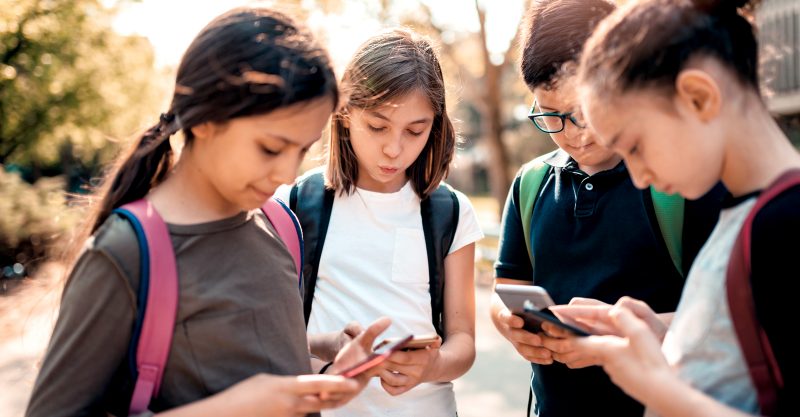Wireless Radiation Exposure for Children Should Be ‘Hundreds of Times Lower’ than FCC Limits, Environmental Group Says
According to a new, peer-reviewed study by the Environmental Working Group, the FCC must consider the latest scientific research, which shows radiation from wireless devices can affect health, especially for children.
The Defender is experiencing censorship on many social channels. Be sure to stay in touch with the news that matters by subscribing to our top news of the day. It's free.
A peer-reviewed study by the Environmental Working Group (EWG) recommends stringent health-based exposure standards for both children and adults for radiofrequency radiation emitted from wireless devices. EWG’s children’s guideline is the first of its kind and fills a gap left by federal regulators.
The study, published in the journal Environmental Health, relies on the methodology developed by the Environmental Protection Agency to assess human health risks arising from toxic chemical exposures. EWG scientists have applied the same methods to radiofrequency radiation from wireless devices, including cellphones and tablets.
EWG recommends the Federal Communications Commission (FCC) adjust its woefully outdated health standards for wireless radiation, last revised a quarter-century ago, well before wireless devices became ubiquitous, heavily used appliances synonymous with modern life.
The recommendation draws on data from a landmark 2018 study from the National Toxicology Program, or NTP, one of the largest long-term studies on the health effects of radiofrequency radiation exposure.
EWG’s new guidelines, the first developed in the U.S. to focus on children’s health, recommend that children’s exposure overall be 200 to 400 times lower than the whole-body exposure limit set by the FCC in 1996.
The EWG recommended limit for so-called whole-body Specific Absorption Rate, or SAR, for children is 0.2 to 0.4 milliwatts per kilogram, or mW/kg. For adults, EWG recommends a whole-body SAR limit of 2 to 4 mW/kg, which is 20 to 40 times lower than the federal limit.
The FCC has not set a separate standard for children. Its standards for radiofrequency radiation set a maximum SAR of 0.08 watts per kilogram, or W/kg, for whole-body exposure and an SAR for localized spatial peak — the highest exposure level for a specific part of the body, such as the brain — of 1.6 W/kg for the general population.
The NTP studies examined the health effects of 2G and 3G wireless radiation and found there is “clear evidence” of a link between exposure to radiofrequency radiation and heart tumors in laboratory animals. Similar results were reported by a team of Italian scientists from the Ramazzini Institute.
Cellphone radiation was classified a “possible carcinogen” in 2011 by the International Agency for Research on Cancer, part of the World Health Organization, a conclusion based on human epidemiological studies that found an increased risk of glioma, a malignant brain cancer, associated with cellphone use.
EWG scientists say that more research is needed on the health impacts of the latest generation of communication technologies, such as 5G. In the meantime, EWG’s recommendation is for strict, lower exposure limits for all radiofrequency sources, especially for children.
When the FCC established its radiofrequency radiation limits, following the passage of the 1996 Telecommunications Act, relatively few Americans, and likely no children, owned and used cellphones.
Much has changed since the federal limits were set, including technology and how these devices are used. A survey completed by the nonprofit Common Sense Media in March 2020, just before the start of the COVID-19 spread in the U.S., found that 46% of 2- to 4-year-olds, and 67% of 5- to 8-year-olds, had their own mobile devices, such as a tablet or smartphone.
With remote learning, a necessity during the COVID-19 pandemic, phones, tablets and other wireless devices became a part of life for young children, tweens and teens nationwide.
“The FCC must consider the latest scientific research, which shows that radiation from these devices can affect health, especially for children,” said Uloma Uche, Ph.D., EWG environmental health science fellow and lead author of the study.
“It has been 25 years since the FCC set its limits for radiofrequency radiation. With multiple sources of radiofrequency radiation in the everyday environment, including Wi-Fi, wireless devices and cell towers, protecting children’s health from wireless radiation exposures should be a priority for the FCC,” she added.
“Based on our review of the health risks and the inadequacy of current standards to protect children, while the science evolves, it is perfectly reasonable for parents to consider minimizing or eliminating radiofrequency radiation sources at home by relying more on wired internet access, and to urge schools to take comparable steps to reduce classroom and campus exposure,” said Cook.
Other health-protective tips for consumers who want to reduce radiofrequency radiation from wireless devices include using a headset or speaker, texting instead of talking, and limiting the time children spend on smartphones.
Find all of EWG’s tips to reduce exposure to wireless radiation here.
EWG’s recommendation for limits for radiofrequency radiation exposure is its latest effort to advance the public dialogue about science-based standards that protect public health.
Originally published by the Environmental Working Group.
The views and opinions expressed in this article are those of the authors and do not necessarily reflect the views of Children's Health Defense.

